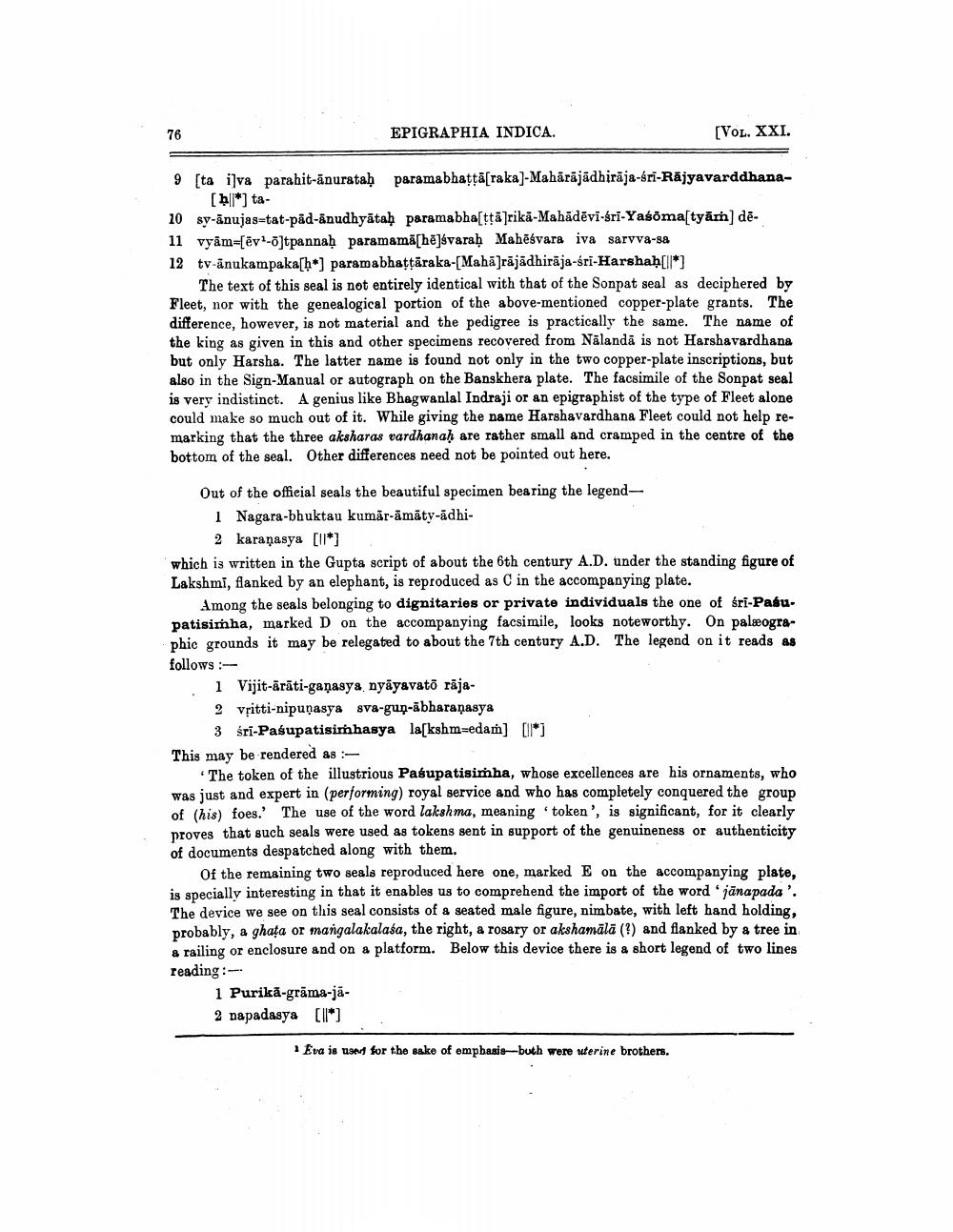________________
EPIGRAPHIA INDICA.
[Vol. XXI.
9 [ta ilva parahit-anurataḥ paramabhattā[raka)-Mahārājādhiraja-bri-Räjyavarddhana
[5/1*] ta10 sy-ānujas tat-pad-änudhyātaḥ paramabha[ttālrikā-Mahādēvī-sri-Yasoma[tyām] de11 vyam-[ëv?-5]tpannaḥ paramamishē]svaraḥ Mahēsvara iva sarvva-sa 12 tv-anukampaka[h*) paramabhattāraka-[Mahā]rājādhirāja-sri-Harshah[/I*]
The text of this seal is not entirely identical with that of the Sonpat seal as deciphered by Fleet, nor with the genealogical portion of the above-mentioned copper-plate grants. The difference, however, is not material and the pedigree is practically the same. The name of the king as given in this and other specimens recovered from Nālandā is not Harshavardhana but only Harsha. The latter name is found not only in the two copper-plate inscriptions, but also in the Sign-Manual or autograph on the Banskhera plate. The facsimile of the Sonpat seal is very indistinct. A genius like Bhagwanlal Indraji or an epigraphist of the type of Fleet alone could make so much out of it. While giving the name Harshavardhana Fleet could not help remarking that the three aksharas vardhanaḥ are rather small and cramped in the centre of the bottom of the seal. Other differences need not be pointed out here.
Out of the official seals the beautiful specimen bearing the legend
1 Nagara-bhuktau kumar-āmātv-adhi
2 karaṇasya [11*] which is written in the Gupta script of about the 6th century A.D. under the standing figure of Lakshmi, flanked by an elephant, is reproduced as C in the accompanying plate.
Among the seals belonging to dignitaries or private individuals the one of Sri-Pasu. patisimha, marked D on the accompanying facsimile, looks noteworthy. On palæographic grounds it may be relegated to about the 7th century A.D. The legend on it reads as follows:
1 Vijit-ärāti-ganasya nyāyavato rāja2 vritti-nipunasya sva-gun-abharaṇasya
3 sri-Pasupatisimhasya la[kshm=edam] [m] This may be rendered as
* The token of the illustrious Pasupatisimha, whose excellences are his ornaments, who was just and expert in (performing) royal service and who has completely conquered the group of (his) foes. The use of the word lakshma, meaning token', is significant, for it clearly proves that such seals were used as tokens sent in support of the genuineness or authenticity of documents despatched along with them.
Of the remaining two seals reproduced here one, marked E on the accompanying plate, is specially interesting in that it enables us to comprehend the import of the word "jānapada'. The device we see on this seal consists of a seated male figure, nimbate, with left hand holding, probably, a ghata or mangalakalasa, the right, a rosary or akshamäla (?) and flanked by a tree in & railing or enclosure and on a platform. Below this device there is a short legend of two lines reading :
1 Purikā-grāma-ja2 napadasya [lk]
1 Eva is und for the sake of emphasis--buth were werine brothers.




